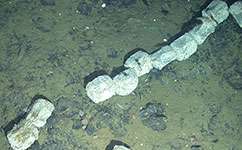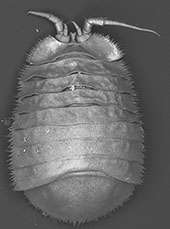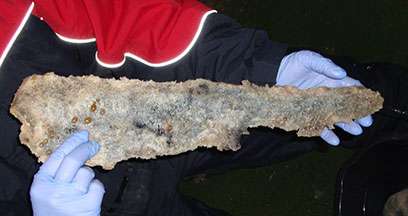New critter discovered on whale carcass

A new species of bug, similar in appearance to the common woodlouse, has been found plastered all over a whale carcass on the floor of the deep Southern Ocean.
Scientists say that Jaera tyleri is the first in its genus to be found in the southern hemisphere, and may be unique to the whale bone habitat.
The bones themselves are a remarkable chance discovery. They were spotted on a live video feed, beamed to scientists aboard the RRS James Cook from a remotely operated vehicle (ROV) on the sea floor.
The UK researchers were searching the depths for hydrothermal vents, or 'black smokers', when they stumbled upon the remains.
'It was a complete surprise,' says Dr Katrin Linse of NERC's British Antarctic Survey, who led the study . 'We were all really thrilled. You could never hope to find a whale fall on purpose - it would be like looking for a needle in a haystack.'
'It gave us a rare opportunity to look at the ecology of these unique habitats, and which sorts of species settle on them.'
'After spotting them on the cameras, we used the robotic arm of the ROV to pull a few of the bones up to the ship to examine them more closely.'
'They were absolutely covered in these little critters - there were 500 to 6,000 specimens per square metre.'

Although the isopod looks similar to a woodlouse, it is smaller, measuring up to just 3.7 millimetres in length. Genetic tests confirmed that the species is new to science.
Its close relations can be found throughout shallower waters in the North Sea but, intriguingly, this is the only species of Jaera ever to be found south of the equator.
'We looked on the rocks and on the sea floor surrounding the bones, but we couldn't find them anywhere else,' says Linse. 'It is possible that they are unique to the whale bone habitat.'

'What would be really interesting to find out, is whether this animal has come from the deep ocean into the shallows, or whether it was the other way round.'
'At the moment it is impossible to say. There could be an awful lot of missing distribution - there is so much of the ocean floor yet to be explored. Maybe somebody else will stumble across a whale fall and that can help us to piece the puzzle together.'
Provided by PlanetEarth Online
This story is republished courtesy of Planet Earth online, a free, companion website to the award-winning magazine Planet Earth published and funded by the Natural Environment Research Council (NERC).




















